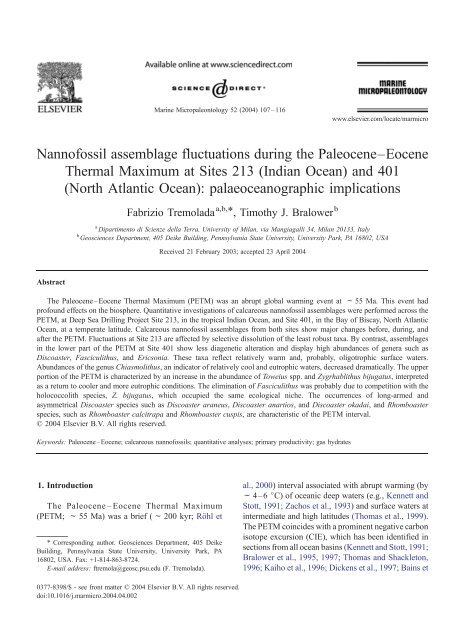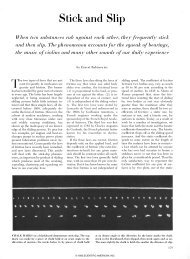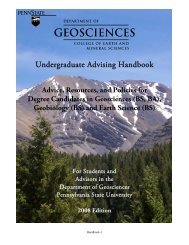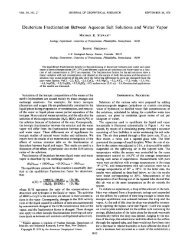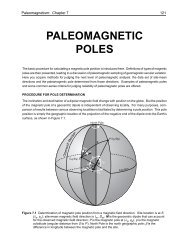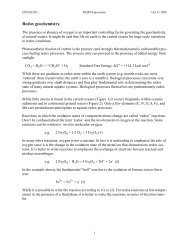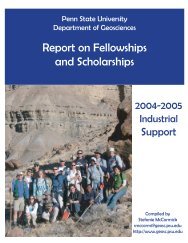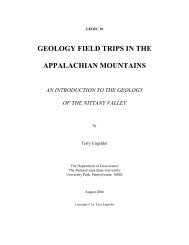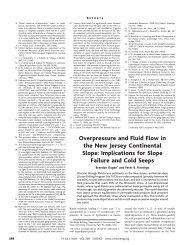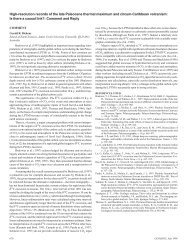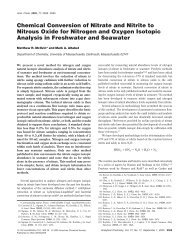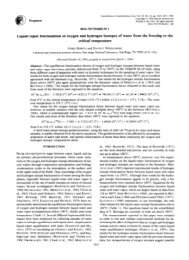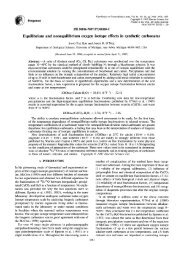Tremolada, F., and Bralower, T. J., 2004 - Penn State University
Tremolada, F., and Bralower, T. J., 2004 - Penn State University
Tremolada, F., and Bralower, T. J., 2004 - Penn State University
Create successful ePaper yourself
Turn your PDF publications into a flip-book with our unique Google optimized e-Paper software.
F. <strong>Tremolada</strong>, T.J. <strong>Bralower</strong> / Marine Micropaleontology 52 (<strong>2004</strong>) 107–116 109not represented due to an unconformity (Müller,1979).DSDP Site 213 was drilled on the eastern side ofthe Ninetyeast Ridge in the Indian Ocean at a palaeolatitudeof 28jS (Fig. 1). A sedimentary successionspanning the Upper Paleocene to Holocene was recovered(von der Borch et al., 1974). The PETMinterval lies in Core 16 <strong>and</strong> consists of brown, clayeysediments <strong>and</strong> nannofossil oozes of latest Paleocene–earliest Eocene age, directly overlying basement. Thebrown clay contains the upper part of the CIE indicatingthat the onset of the event is missing (Ravizzaet al., 2001).The PETM at both sites was sampled every centimetre.Quantitative analyses were carried out on 120samples from Sites 213 <strong>and</strong> 78 samples from Site 401.The PETM interval was investigated in 49 samplesfrom Site 213 <strong>and</strong> 51 samples from Site 401. Smearslides were prepared from well-mixed <strong>and</strong> unsettledsediment suspensions, <strong>and</strong> no ultrasonic cleaning orcentrifuge concentration was applied in order to retainthe original nannofossil composition. Nannofossilswere observed in the light microscope at 1250 magnification <strong>and</strong> identified following the taxonomicschemes of Aubry (1984, 1988, 1989, 1990), Perch-Nielsen (1985), <strong>and</strong> Varol (1998). Three hundredspecimens were counted in each smear slide. The firstseries of analyses on samples from Site 401 revealedthat the genus Toweius dominated the nannofossilassemblages. Supplementary counts of 250 specimens,excluding the genus Toweius, were thus undertakenin order to raise the percentages of other taxa tostatistically significant levels (<strong>Bralower</strong>, 2002). Interpretationsat Site 401 are based on the non-Toweiusfraction. If possible, specimens were identified at thespecies level during counts, <strong>and</strong> grouped at thegeneric level for analysis (Figs. 2–5).3. ResultsThe calcareous nannofossil assemblages throughthe PETM at Sites 401 <strong>and</strong> 213 show similar trends,but the magnitudes of the fluctuations are different.Nannofossils at Site 401 are very well preserved <strong>and</strong>display a high species richness throughout the intervalFig. 2. Calcareous nannofossil (placoliths <strong>and</strong> Octolithus multiplus) assemblage fluctuations across the PETM at Site 401. NP biozonation afterMartini (1971); CP biozonation after Okada <strong>and</strong> Bukry (1980). Grey b<strong>and</strong> indicates thermal maximum. Dashed line marks the boundarybetween the lower <strong>and</strong> upper parts of PETM.
110F. <strong>Tremolada</strong>, T.J. <strong>Bralower</strong> / Marine Micropaleontology 52 (<strong>2004</strong>) 107–116Fig. 3. Calcareous nannofossil (holococcoliths <strong>and</strong> nannoliths) assemblage fluctuations across the PETM at Site 401. NP <strong>and</strong> CP biozonations asin Fig. 2. Grey b<strong>and</strong> indicates thermal maximum. Dashed line marks the boundary between the lower <strong>and</strong> upper parts of PETM.investigated, with a slight decrease in species richnessin the lower portion of the PETM (Figs. 2 <strong>and</strong> 3).Assemblages are dominated by the genus Toweius,which comprises 45–74% of the entire assemblage.Other genera, such as Discoaster, Sphenolithus, Fasciculithus,Ericsonia, <strong>and</strong> Chiasmolithus, <strong>and</strong> thespecies Octolithus multiplus, rarely constitute 10%of the total assemblages.Counts from the interval below the PETM showthe typical Upper Paleocene nannofossil assemblagesof northern high latitudes, with high abundances ofToweius spp., Octolithus multiplus <strong>and</strong> Chiasmolithusspp. However, a significant abundance peak of Biscutum?sp. (Biscutum sp. of <strong>Bralower</strong>, 2002) <strong>and</strong> Prinsiusbisulcus was recognized just below the onset ofthe PETM. The PETM interval can be subdivided intoa lower part <strong>and</strong> an upper part on the basis of thenannofossil assemblages. The lower part is characterizedby a sharp increase of Discoaster, Fasciculithus,<strong>and</strong> Ericsonia spp. The genus Fasciculithus is mainlyrepresented by Fasciculithus tympaniformis, whereasother species display very low abundances. Discoastermultiradiatus <strong>and</strong> Discoaster lenticularis rangefrom 8% to 15% of the non-Toweius fraction, <strong>and</strong>long-armed <strong>and</strong> asymmetrical discoaster species, suchas Discoaster araneus, Discoaster anartios, <strong>and</strong> Discoasterokadai have their first occurrence during thistime interval, as previously documented by Cramer etal. (2000), Monechi et al. (2000), <strong>Bralower</strong> (2002),<strong>and</strong> Kahn <strong>and</strong> Aubry (<strong>2004</strong>).In the upper part of the PETM, a decrease inabundance of Discoaster spp. <strong>and</strong> Fasciculithus spp.is evident, whereas Toweius spp. <strong>and</strong> Zygrhablithusbijugatus abruptly increase in abundance. Sphenolithusspp. increase slightly in abundance in the upperpart of the PETM, <strong>and</strong> consist largely of Sphenolithusmoriformis, Sphenolithus primus, <strong>and</strong> Sphenolithusanarrhopus; however, this group accounts for less
112F. <strong>Tremolada</strong>, T.J. <strong>Bralower</strong> / Marine Micropaleontology 52 (<strong>2004</strong>) 107–116than 10% of the nannofossil assemblages in allsamples. The genus Chiasmolithus is either rare orabsent in the PETM interval. The last occurrence ofOctolithus multiplus at Sites 401 <strong>and</strong> 1051 (BlakeNose, NE Atlantic) has been observed at the onset ofthe PETM (Kulhanek <strong>and</strong> Watkins, 2002).Counts of samples from Site 213 indicate markedchanges in the composition <strong>and</strong> preservation of theassemblages through the interval analyzed (Figs. 4 <strong>and</strong>5). Preservation in samples ranges from moderate togood. The brown claystones display assemblages withvery low species richness ( < 20 species), almost entirelycomposed of solution-resistant taxa, whereasassemblages in the oozes are better preserved <strong>and</strong>richer (>40 species). Brown claystone samples aredominated by nannoliths, such as Fasciculithus spp.,Sphenolithus spp., <strong>and</strong> Discoaster spp., <strong>and</strong> a fewplacolith taxa, such as Ericsonia spp., Campylosphaeradela, <strong>and</strong> Pedinocyclus praelarvalis (see <strong>Bralower</strong><strong>and</strong> Mutterlose, 1995). The abundance ofToweius is < 15% of the entire assemblage <strong>and</strong> Chiasmolithusis absent. The calcareous oozes overlying thebrown claystone show very different assemblage compositions,with sharp drops in the abundances ofFasciculithus spp. <strong>and</strong> Discoaster spp., <strong>and</strong> a lesspronounced decrease in the abundance of Sphenolithusspp., P. praelarvalis, <strong>and</strong> C. dela. The genus Toweiusbecomes very abundant (>20% of the nannofossilassemblages), but never as dominant as at higherlatitudes. In addition, the holococcolith species, Zygrhablithusbijugatus, displays a significant abundanceincrease (up to 10%) <strong>and</strong> an inverse correlation withthe genus Fasciculithus. The abundances of Chiasmolithusspp. <strong>and</strong> Biscutum? sp. increase slightly, but are< 5% throughout the section.4. Calcareous nannofossil palaeoecologyCalcareous nannoplankton are sensitive to environmentalchanges in their surface water habitats; thus,changes in the abundance of fossil assemblages can beinterpreted as a response to palaeoceanographic perturbations.Several palaeobiogeographic studies haveaddressed the ecological affinities of a number ofPaleogene taxa (Haq <strong>and</strong> Lohmann, 1976; Haq etal., 1977; Backman, 1986; Wei <strong>and</strong> Wise, 1990;Hallock et al., 1991; Aubry, 1992, 1998; <strong>Bralower</strong>,2002): the genera Discoaster <strong>and</strong> Ericsonia appear tohave tolerated warm <strong>and</strong> oligotrophic waters, whereasBiscutum? sp., Chiasmolithus, <strong>and</strong> Toweius are likelyindicators of colder <strong>and</strong> more eutrophic waters. Inaddition, Zygrhablithus bijugatus was interpreted asan oligotrophic species by Aubry (1998). The ecologicalaffinities of Fasciculithus <strong>and</strong> Sphenolithus areunclear, even though these genera seem to display aninverse correlation with Prinsius martinii—a speciesthat is abundant in eutrophic, high-latitude environments(Haq <strong>and</strong> Lohmann, 1976).The nannofossil assemblage fluctuations observedthrough the PETM at Sites 213 <strong>and</strong> 401 correlate withthose at southern high-latitude ODP Site 690 (<strong>Bralower</strong>,2002) <strong>and</strong> the Tethyan section at Alamedilla,southern Spain (Monechi et al., 2000). Toweiusincreases in abundance in the later part of the PETMat Sites 690 (<strong>Bralower</strong>, 2002) <strong>and</strong> 401, but it showslow abundances in the brown claystones of Site 213.This genus is abundant at higher latitudes <strong>and</strong> hasbeen interpreted as a mesotrophic form (<strong>Bralower</strong>,2002).The nannofossil assemblages in the lower part ofthe PETM at Sites 401 <strong>and</strong> 690 are thus indicative ofwarm <strong>and</strong> oligotrophic conditions, whereas the upperportion of the event at these sites were likely characterizedby more eutrophic conditions (<strong>Bralower</strong>,2002). The high abundances of Fasciculithus spp.are not easily interpretable, but may indicate oligotrophicconditions.5. InterpretationsThe Paleocene–Eocene transition shows a range ofsignificant biotic <strong>and</strong> geochemical changes. Bloomsof the dinoflagellate genus, Apectodinium, in coastalenvironments (Fig. 6) are likely indicative of highsurface water productivity <strong>and</strong> increased temperature(Crouch et al., 2001). Benthic foraminiferal assemblagesat open ocean <strong>and</strong> shelf sites are thought to beindicators of high nutrient concentrations, likely as aresult of eutrophic conditions (Thomas <strong>and</strong> Shackleton,1996; Speijer <strong>and</strong> Schmitz, 1998; Thomas, 1998;Thomas et al., 2000).High biogenic barium accumulation rates at openocean PETM sections have been interpreted as evidencefor widespread high productivity (Bains et al.,
F. <strong>Tremolada</strong>, T.J. <strong>Bralower</strong> / Marine Micropaleontology 52 (<strong>2004</strong>) 107–116 113Fig. 6. Summary of biotic, geochemical, <strong>and</strong> volcanic events, which occurred across the interval of the PETM. Calcareous nannofossil eventsare a synthesis of the results from Sites 213, 401, <strong>and</strong> 690.2000). However, the interpretation of barium as aproxy for productivity is problematic due to its shortresidence time (f 8 kyr) <strong>and</strong> the potential increase inbarium fluxes as a result of methane dissociation(Dickens et al., 2003).Organic carbon content is difficult to interpret interms of productivity, but provides some information.Shallower water sections, in Kazakhstan <strong>and</strong> Uzbekistan,show highly anoxic conditions <strong>and</strong> organicmatter of marine origin, with total organic carbon(TOC) ranging from ca. 0.2% to 8% (Bolle et al.,2000). These concentrations are possibly indicative ofhighly productive surface waters.Evidence of dysoxic conditions is recorded infinely laminated sediments at ODP Site 999 in theColombia Basin (Caribbean Sea), where TOC is< 0.3% (<strong>Bralower</strong> et al., 1997)—only slightly higherthan in the underlying <strong>and</strong> overlying sediments. Thedecrease in the degree of bioturbation at the beginningof the PETM at Site 690 (Thomas <strong>and</strong> <strong>Bralower</strong>,2001; <strong>Bralower</strong>, 2002) is associated with very lowTOC (f 0.1%). The finely laminated sediments atSite 999 <strong>and</strong> the decrease of bioturbation at Site 690indicate diminished deep-water oxygenation, but thelack of organic matter at these sites has been interpretedto reflect low organic carbon fluxes fromsurface waters as a consequence of oligotrophy (<strong>Bralower</strong>,2002).Open ocean nannofossil assemblages at Sites 213,401, <strong>and</strong> 690 are generally indicative of low productivity,in contrast with more proximal settings, whichwere characterized by higher productivity (Fig. 7), asdocumented by major changes in dinoflagellateassemblages (Crouch et al., 2001).The peaks in Biscutum? sp. <strong>and</strong> P. bisulcusimmediately below the CIE at Sites 401 <strong>and</strong> 690,interpreted as an increase in fertility of surfacewaters (<strong>Bralower</strong>, 2002), might be unrelated to thePETM.The formation of the NAIP likely triggered greenhouseconditions during the Paleocene–Eocene transition(Eldholm <strong>and</strong> Thomas, 1993), <strong>and</strong> possiblycaused the release of methane hydrates (Fig. 7). Theoxidation of hydrates consumed a large amount ofoxygen in the ocean (Thomas et al., 2002) <strong>and</strong> addeda massive amount of carbon dioxide to the oceans <strong>and</strong>atmosphere (e.g., Dickens et al., 1995, 1997). Inproximal settings, increased runoff (Robert <strong>and</strong> Kennett,1994) could have led to high productivity, which,combined with low oxygen concentrations, resulted inhigh TOC contents in the sediments. Lower TOCcontents in open ocean sites can be explained by a
114F. <strong>Tremolada</strong>, T.J. <strong>Bralower</strong> / Marine Micropaleontology 52 (<strong>2004</strong>) 107–116Fig. 7. Palaeoceanographic model for causes <strong>and</strong> effects of the PETM in greenhouse conditions.combination of somewhat higher oxygenation <strong>and</strong>lower productivity (Fig. 6).The PETM triggered the rapid radiation of theplanktonic foraminifera (e.g., Kelly et al., 1996) <strong>and</strong>l<strong>and</strong> mammals (e.g., Clyde <strong>and</strong> Gingerich, 1998).The rate of extinction in the benthic foraminiferalcommunities varies from tropical to high latitude sites(e.g., Kaiho et al., 1996; Speijer et al., 1996). Theextinction of the northern temperate-latitude <strong>and</strong> highlatitudenannofossil species, Octolithus multiplus, waslikely caused by increasing temperature, <strong>and</strong> theelimination of Fasciculithus possibly resulted fromcompetition with Zygrhablithus bijugatus. Furthermore,palynofloras show no extinctions <strong>and</strong> onlymoderate changes in composition <strong>and</strong> diversity duringthe Paleocene–Eocene transition (e.g., Wing <strong>and</strong>Harrington, 2001).6. ConclusionsNannofloral changes associated with the PETMtransition at DSDP Sites 213 <strong>and</strong> 401 correlate withthose documented from several other locations, suchas ODP Site 690 (<strong>Bralower</strong>, 2002) <strong>and</strong> Alamedilla,southern Spain (Monechi et al., 2000). The PETM canbe subdivided into a lower part <strong>and</strong> a upper part on thebasis of nannofossil assemblages. The lower part ischaracterized by high abundances of Discoaster spp.,Ericsonia spp., <strong>and</strong> Fasciculithus spp., interpreted asindicators of warm surface waters <strong>and</strong> probably oligotrophicconditions (Wei <strong>and</strong> Wise, 1990; Aubry,1992; Kelly et al., 1996; <strong>Bralower</strong>, 2002). The upperpart shows an increase in abundance of Toweius spp.<strong>and</strong> Zygrhablithus bijugatus, which likely reflectsmore eutrophic <strong>and</strong> cooler conditions.The major nannofloral changes at DSDP Site 213seem to be strongly affected by diagenesis. Theincrease in abundance of genera most resistant todissolution, such as Discoaster, Ericsonia, <strong>and</strong> Fasciculithus,inversely correlates with the nannofossilspecies richness at Site 213.The appearance of asymmetrical Discoaster <strong>and</strong>Rhomboaster species might indicate the development<strong>and</strong> availability of new ecological niches, resultingfrom major palaeoceanographic changes during thePETM (<strong>Bralower</strong>, 2002). The last occurrence ofOctolithus multiplus might be a reliable bioevent atnorthern intermediate <strong>and</strong> high latitudes.AcknowledgementsWe gratefully acknowledge K. von Salis, J. Young,J. Lees, <strong>and</strong> an anonymous reviewer for criticalcomments that helped us improve the manuscript.Many thanks to I. Premoli Silva, E. Erba, I. Raffi, J.Backman, <strong>and</strong> G. Dickens for thoughtful discussions.Samples were provided by the Ocean DrillingProgram, <strong>and</strong> we thank the curatorial staff for their
F. <strong>Tremolada</strong>, T.J. <strong>Bralower</strong> / Marine Micropaleontology 52 (<strong>2004</strong>) 107–116 115help. This work was funded by Cofin 2001 to I.Premoli Silva, NSF EAR-9814604 <strong>and</strong> OCE-0084032(to T.J. <strong>Bralower</strong>).ReferencesAubry, M.-P., 1984. H<strong>and</strong>book of Cenozoic Calcareous Nannoplankton:Book 1. Ortholithae (Discoasters). MicropaleontologyPress, American Museum of Natural History, New York, NY.266 pp.Aubry, M.-P., 1988. H<strong>and</strong>book of Cenozoic Calcareous Nannoplankton:Book 2. Ortholithae (Holococcoliths, Ceratoliths,Ortholiths <strong>and</strong> Others). Micropaleontology Press, AmericanMuseum of Natural History, New York, NY. 279 pp.Aubry, M.-P., 1989. H<strong>and</strong>book of Cenozoic Calcareous Nannoplankton:Book 3. Ortholithae (Pentaliths, <strong>and</strong> Others), Heliolithae(Fasciculiths, Sphenoliths <strong>and</strong> Others). Micropaleontology Press,American Museum of Natural History, New York, NY. 279 pp.Aubry, M.-P., 1990. H<strong>and</strong>book of Cenozoic Calcareous Nannoplankton:Book 4. Heliolithae (Helicoliths, Cribriliths, Lopadoliths<strong>and</strong> Others) Micropaleontology Press, American Museumof Natural History, New York, NY 381 pp..Aubry, M.-P., 1992. Late Paleogene nannoplankton evolution: atale of climatic deterioration. In: Prothero, D.R., Berggren,W.A. (Eds.), Eocene–Oligocene Climatic <strong>and</strong> Biotic Evolution.Princeton Univ. Press, Princeton, NJ, pp. 272–309.Aubry, M.-P., 1998. Early Paleogene calcareous nannoplanktonevolution: a tale of climatic amelioration. In: Aubry, M.-P.,Lucas, S., Berggren, W.A. (Eds.), Late Paleocene <strong>and</strong> EarlyEocene Climatic <strong>and</strong> Biotic Evolution. Columbia Univ. Press,New York, pp. 158–203.Backman, J., 1986. Late Paleocene to middle Eocene calcareousnannofossil biochronology from the shatsky rise WalvisRidge <strong>and</strong> Italy. Palaeogeogr. Palaeoclimatol. Palaeoecol.57, 43–59.Bains, S., Corfield, R.M., Norris, R.D., 1999. Mechanisms ofclimate warming at the end of the Paleocene. Science 285,724–727.Bains, S., Norris, R.D., Corfield, R.M., Faul, K.L., 2000. Terminationof global warmth at the Palaeocene/Eocene boundarythrough productivity feedback. Nature 407, 171–174.Bolle, M.P., Pardo, A., Hinrichs, K.U., Adatte, T., von Salis, K.,Burns, S., Keller, G., Muzylev, N., 2000. The Paleocene–Eocenetransition in the marginal northeastern Tethys (Kazakhstan<strong>and</strong> Uzbekistan). Int. J. Earth Sci. 89, 390–414.<strong>Bralower</strong>, T.J., 2002. Evidence of surface water oligotrophy duringthe Paleocene–Eocene Thermal Maximum: nannofossil assemblagedata from Ocean Drilling Program Site 690 Maud Rise,Weddell Sea. Paleoceanography 17, 1–13.<strong>Bralower</strong>, T.J., Mutterlose, J., 1995. Calcareous nannofossil biostratigraphyof ODP Site 865, Allison Guyot, Central PacificOcean: a tropical Paleogene reference section. In: Winterer,E.L., Sager, W.W., Firth, J.V. (Eds.), Proceedings of the OceanDrilling Program. Scientific Results, vol. 143, pp. 31–72.<strong>Bralower</strong>, T.J., Zachos, J.C., Thomas, E., Parrow, M., Paull, C.K.,Kelly, D.C., Premoli Silva, I., Sliter, W.V., Lohmann, K.C.,1995. Late Paleocene to Eocene paleoceanography of the equatorialPacific Ocean: stable isotopes recorded at ODP Site 865Allison Guyot. Paleoceanography 10, 841–865.<strong>Bralower</strong>, T.J., Thomas, D.J., Zachos, J.C., Hirschmann, M.M., Röhl,U., Sigurdsson, H., Thomas, E., Whitney, D.L., 1997. High-resolutionrecords of the late Paleocene thermal maximum <strong>and</strong> circum-Caribbeanvolcanism: is there a causal link? Geology 25,963–967.Clyde, W.C., Gingerich, P.D., 1998. Mammalian community responseto the latest Paleocene thermal maximum: an isotaphonomicstudy in the northern Bighorn Basin Wyoming. Geology26, 1011 – 1014.Cramer, B., Miller, K.G., Aubry, M.-P., Olsson, R.K., Wright, J.D.,Kent, D.V., Browning, J.V., 2000. The Bass River Section: anexceptional record of the LPTM event in a neritic setting. Bull.Geol. Soc. Fr. 170, 883–897.Crouch, E.M., Heilmann-Clausen, C., Brinkhuis, H., Morgans,H.E.G., Rogers, K.M., Egger, H., Schmitz, B., 2001. Globaldinoflagellate event associated with the late Paleocene thermalmaximum. Geology 29, 315–318.Dickens, G.R., O’Neil, J.R., Rea, D.K., Owen, R.M., 1995. Dissociationof oceanic methane hydrate as a cause of the carbonisotope excursion at the end of the Paleocene. Paleoceanography10, 965–971.Dickens, G.R., Castillo, M.M., Walker, J.G.C., 1997. A blast of gasin the latest Paleocene: simulating first-order effects of massivedissociation of oceanic methane hydrate. Geology 25, 259–262.Dickens, G.R., Fewless, T., Thomas, E., <strong>Bralower</strong>, T.J., 2003. Excessbarite accumulation during the Paleocene/Eocene thermalmaximum: massive input of dissolved barium from seafloor gashydrate reservoirs. In: Wing, S.L., Gingerich, P.D., Schmitz, B.,Thomas, E. (Eds.), Causes <strong>and</strong> Consequences of Globally WarmClimates in the Early Paleogene. Geological Society of AmericaSpecial Publication, vol. 369, pp. 11–23.Eldholm, O., Thomas, E., 1993. Environmental impact of volcanicmargin formation. Earth Planet. Sci. Lett. 117, 319–329.Hallock, P., Premoli Silva, I., Boersma, A., 1991. Similaritiesbetween planktonic <strong>and</strong> larger foraminiferal evolutionarytrends through paleoceanographic changes. Palaeogeogr. Palaeoclimatol.Palaeoecol. 83, 49–64.Haq, B.U., Lohmann, G.P., 1976. Early Cenozoic calcareous nannoplanktonbiogeography of the Atlantic Ocean. Mar. Micropaleontol.1, 119–194.Haq, B.U., Premoli Silva, I., Lohmann, G.P., 1977. Calcareousplankton paleobiogeographic evidence for major climatic fluctuationsin the Early Cenozoic Atlantic Ocean. J. Geophys. Res.82, 3876–3961.Kahn, A., Aubry, M.-P., this volume. Provincialism associated withthe Paleocene/Eocene Thermal Maximum: temporal constraint.Mar. Micropaleontol. Spec. Issue.Kaiho, K., Arinobu, T., Ishiwatari, R., Morgans, H., Okada, H.,Takeda, N., Tazaki, N., Zhou, G., Kajiwara, Y., Matsumoto,R., Hirai, A., Niitsuma, N., Wada, H., 1996. Latest Paleocenebenthic foraminiferal extinction <strong>and</strong> environmental changes atTawanui New Zeal<strong>and</strong>. Paleoceanography 11, 447–465.
116F. <strong>Tremolada</strong>, T.J. <strong>Bralower</strong> / Marine Micropaleontology 52 (<strong>2004</strong>) 107–116Katz, M.E., Pak, D.K., Dickens, G.R., Miller, K.G., 1999. Thesource <strong>and</strong> fate of massive carbon input during the latest Paleocenethermal maximum. Science 286, 1531–1533.Kelly, D.C., <strong>Bralower</strong>, T.J., Zachos, J.C., Premoli Silva, I., Thomas,E., 1996. Rapid diversification of planktonic foraminifera in thetropical Pacific (ODP Site 865) during the late Paleocene thermalmaximum. Geology 24, 423–426.Kelly, D.C., <strong>Bralower</strong>, T.J., Zachos, J.C., 1998. Evolutionary consequencesof the latest Paleocene thermal maximum for tropicalplanktonic foraminifera. Palaeogeogr. Palaeoclimatol. Palaeoecol.141, 139–161.Kennett, J.P., Stott, L.D., 1991. Abrupt deep-sea warming, palaeoceanographicchanges <strong>and</strong> benthic extinctions at the end of thePalaeocene. Nature 353, 225–229.Koch, P.L., Zachos, J.C., Gingerich, P.D., 1992. Coupled isotopicchange in marine <strong>and</strong> continental carbon reservoirs at the Palaeocene/Eoceneboundary. Nature 358, 319–322.Koch, P.L., Zachos, J.C., Dettman, D.L., 1995. Stable isotope stratigraphy<strong>and</strong> paleoclimatology of the Paleogene Bighorn Basin(Wyoming, USA). Palaeogeogr. Palaeoclimatol. Palaeoecol.115, 61–89.Kulhanek, D.K., Watkins, D.K., 2002. Paleocene calcareous nannofossilbiostratigraphy <strong>and</strong> magnetobiochronology from ODP Leg171B Blake Nose. J. Nannoplankton Res. 24, 127–128.Martini, E., 1971. St<strong>and</strong>ard tertiary <strong>and</strong> quaternary calcareousnannoplankton zonation. In: Farinacci, A. (Ed.), Proceedingsof the 2nd Planktonic Conference, Roma. Tecnoscienza, Rome,pp. 739–785.Monechi, S., Angori, E., von Salis, K., 2000. Calcareous nannofossilturnover around the Paleocene/Eocene transition at Alamedilla(southern Spain). Bull. Soc. Geol. Fr. 171, 477–489.Montadert, L., Roberts, D.G, et al., 1979. Initial Reports of theDeep Sea Drilling Project, vol. 48. US Government PrintingOffice, Washington, DC. 1183 pp.Müller, C., 1979. Calcareous nannofossils from the North Atlantic(Leg 48). In: Montadert, L., Roberts, D.G., et al., (Eds.), InitialReports of the Deep Sea Drilling Project, vol. 48. US GovernmentPrinting Office, Washington, DC, pp. 589–640.Okada, H., Bukry, D., 1980. Supplementary modifications <strong>and</strong> introductionof code numbers to the low latitude coccolith biostratigraphiczonation. Mar. Micropaleontol. 5, 321–325.Perch-Nielsen, K., 1985. Mesozoic calcareous nannofossils. In:Bolli, H.M., Saunders, J.B., Perch-Nielsen, K. (Eds.), PlanktonStratigraphy. Cambridge Univ. Press, Cambridge, pp. 329–426.Ravizza, G., Norris, R.N., Blusztajn, J., Aubry, M.-P., 2001. Anosmium isotope excursion associated with the late Paleocenethermal maximum: evidence of intensified chemical weathering.Paleoceanography 16, 155–163.Robert, C., Kennett, J.P., 1994. Antarctic subtropical humid episodeat the Paleocene–Eocene boundary: clay mineral evidence. Geology22, 211–214.Röhl, U., <strong>Bralower</strong>, T.J., Norris, R.D., Wefer, G., 2000. New chronologyfor the late Paleocene thermal maximum <strong>and</strong> its environmentalimplications. Geology 28, 927–930.Speijer, R.P., Van der Zwaan, G.J., Schmitz, B., 1996. The impact ofPaleocene/Eocene boundary events on middle neritic foraminiferalassemblages from Egypt. Mar. Micropaleontol. 28, 99–132.Speijer, R.P., Schmitz, B., 1998. A benthic foraminiferal record ofPaleocene sea-level changes <strong>and</strong> trophic conditions at GebelAweina Egypt. Palaeogeogr. Palaeoclimatol. Palaeoecol. 137,79–102.Thomas, E., 1998. Biogeography of the late Paleocene benthicforaminiferal extinction. In: Aubry, M.-P., Lucas, S.G., Berggren,W.A. (Eds.), Late Paleocene–Early Eocene: Climatic <strong>and</strong>Biotic Events in the Marine <strong>and</strong> Terrestrial Records. ColumbiaUniv. Press, New York, NY, pp. 214–235.Thomas, E., <strong>Bralower</strong>, T.J., 2001. High-resolution Benthic <strong>and</strong>Planktonic records of ecological changes at the PETM at SouthernOcean Site 690. Proceedings of the Paleogene Climate Conference,Powell, WY, pp. 66–67.Thomas, E., Shackleton, N.J., 1996. The latest Paleocene benthicforaminiferal extinction <strong>and</strong> stable isotope anomalies.In: Knox, R.O., Corfield, R.M., Dunay, R.E. (Eds.), Correlationof the Early Paleogene in Northwest Europe. GeologicalSociety of London Special Publication, vol. 101,pp. 401–441.Thomas, D.J., <strong>Bralower</strong>, T.J., Zachos, J.C., 1999. New evidence forsubtropical warming during the late Paleocene thermal maximum:stable isotopes from Deep Sea Drilling Project Site 527,Walvis Ridge. Paleoceanography 14, 561–570.Thomas, E., Zachos, J.C., <strong>Bralower</strong>, T.J., 2000. Ice-free to glacialworld transition as recorded by benthic foraminifera. In:Huber, B.T., MacLeod, K.G., Wing, S.L. (Eds.), Warm Climatesin Earth History. Cambridge Univ. Press, Cambridge,pp. 132–160.Thomas, D.J., Zachos, J.C., <strong>Bralower</strong>, T.J., Thomas, E., Bohaty, S.,2002. Warming the fuel for the fire: evidence for the thermaldissociation of methane hydrate during the Paleocene–EoceneThermal Maximum. Geology 30, 1067–1070.Varol, O., 1998. Paleogene. In: Bown, P.R. (Ed.), Calcareous NannofossilBiostratigraphy. Kluwer Academic Publishing, Dordrecht,pp. 201–224.von der Borch, C.C., Sclater, J.G., et al., 1974. Initial Reports of theDeep Sea Drilling Project, vol. 22. US Government PrintingOffice, Washington DC. 890 pp.Wei, W., Wise Jr., S.W., 1990. Biogeographic gradients of middleEocene– Oligocene calcareous nannoplankton in the SouthAtlantic Ocean. Palaeogeogr. Palaeoclimatol. Palaeoecol. 79,29–61.Wing, S.L., Harrington, G.J., 2001. Floral response to rapid warmingin the earliest Eocene <strong>and</strong> implications for concurrent faunalchange. Paleobiology 27, 539–563.Zachos, J.C., Lohmann, K.C., Walker, J.C.G., Wise Jr., S.W., 1993.Abrupt climate change <strong>and</strong> transient climates during the Paleogene:a marine perspective. J. Geol. 101, 191–213.


